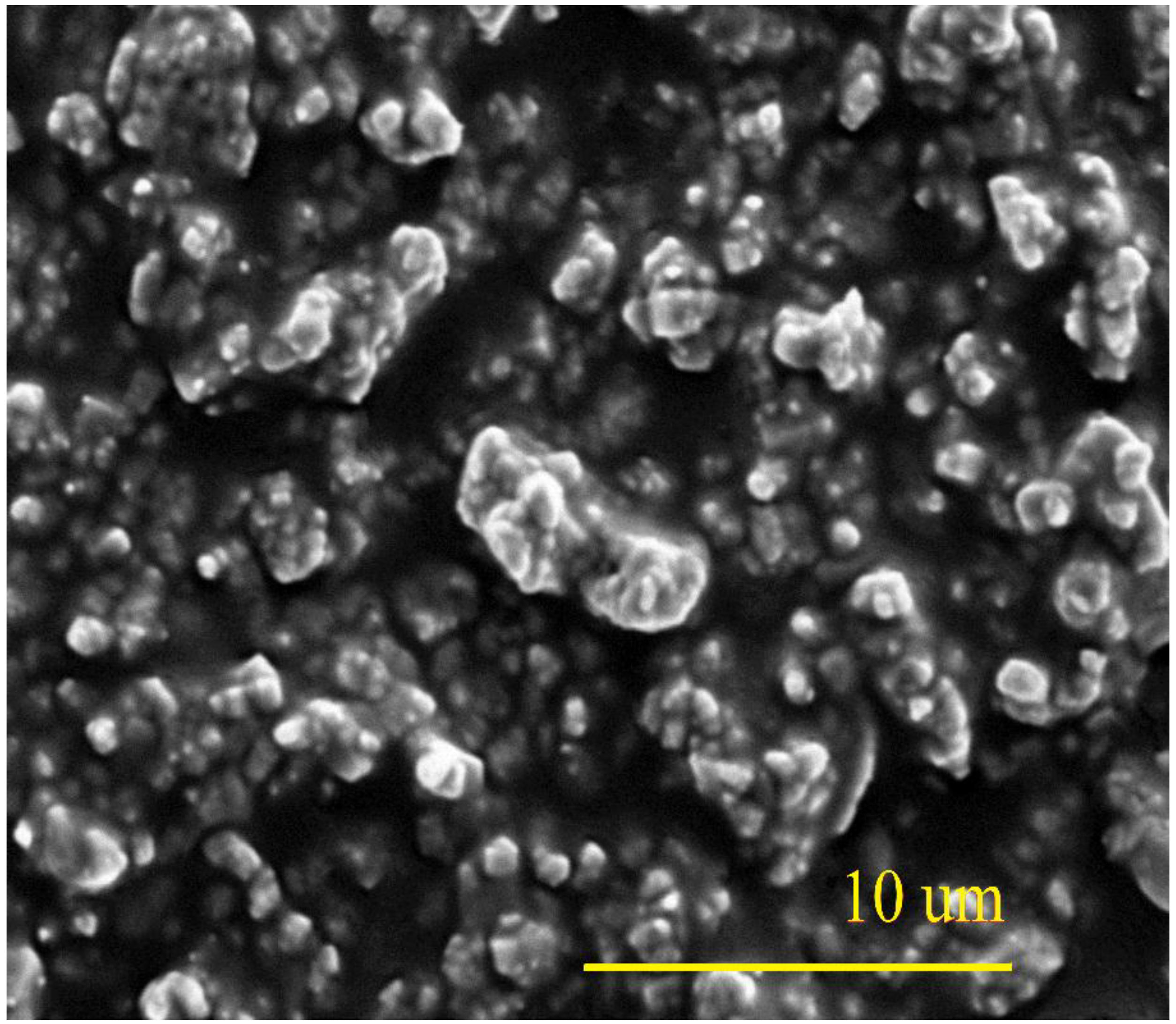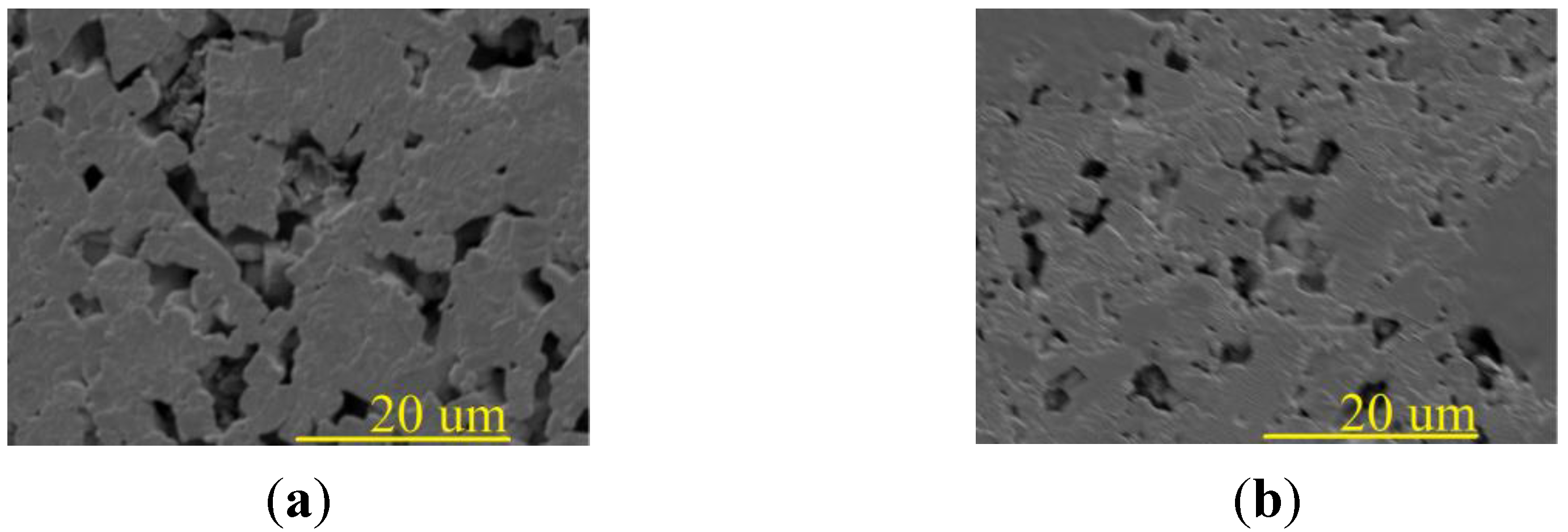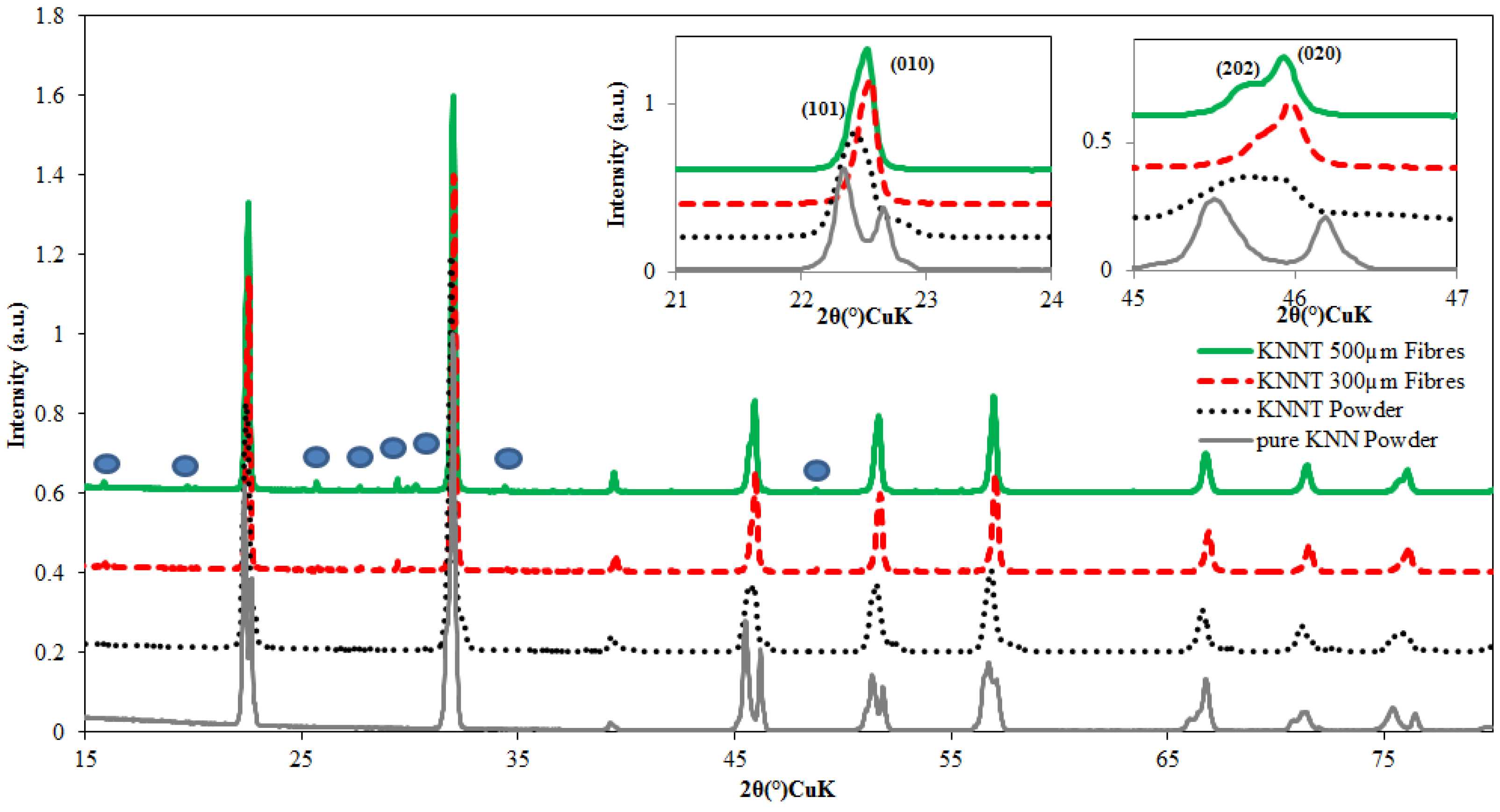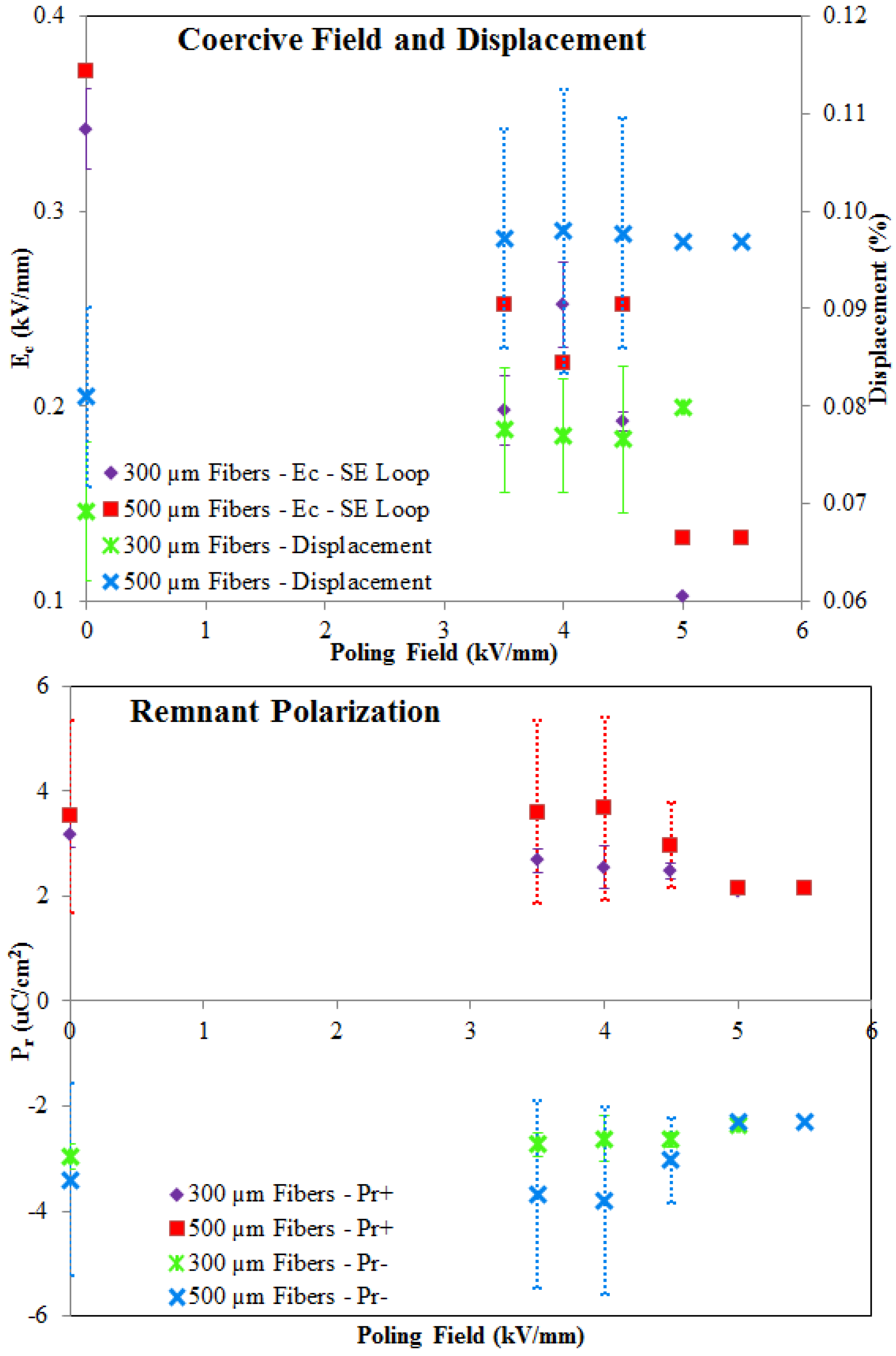Ferroelectric KNNT Fibers by Thermoplastic Extrusion Process: Microstructure and Electromechanical Characterization
Abstract
:1. Introduction
2. Experimental Section

3. Results and Discussion
3.1. Microstructure and Phase Investigation
| Powder Characteristics | |||
|---|---|---|---|
| Density | 5.68 g/cm3 | ||
| Specific Surface Area | 0.786 m2/g | ||
| Particle Size | d10 (µm) | d50 (µm) | d90 (µm) |
| 0.131 | 1.88 | 4.438 | |

| 300-µm Fibers | 500-µm Fibers | |
|---|---|---|
| Porosity (%) | 36.9 ± 6.8 | 27.6 ± 4.7 |
| Grain Size (µm) | 1.27 ± 0.01 | 1.41 ± 0.01 |

 , extra phases, K2Nb8O21 and K3NbO4.
, extra phases, K2Nb8O21 and K3NbO4.
 , extra phases, K2Nb8O21 and K3NbO4.
, extra phases, K2Nb8O21 and K3NbO4.
| Element | 300-µm Fibers | 500-µm Fibers | ||
|---|---|---|---|---|
| wt% | at% | wt% | at% | |
| K | 5.06 | 5.97 | 6.62 | 8.48 |
| Na | 5.41 | 10.85 | 5.04 | 10.98 |
| Nb | 22.29 | 11.06 | 24 | 12.95 |
| Ta | 46.3 | 11.8 | 46.9 | 12.99 |
| O | 20.93 | 60.32 | 17.43 | 54.6 |
3.2. Electromechanical Investigation


| Poled at 3.5 kV/mm | Poled at 4.0 kV/mm | Poled at 4.5 kV/mm | Poled at 5.0 kV/mm | |
| Piezoelectric Coefficient | d33 (pC/N) | |||
| 300-µm Fibers | 62 ± 5 | 65 ± 6 | 64 * ± 6 | 66 ** |
| 500-µm Fibers | 97 ± 22 | 89 ± 35 | 101* ± 32 | 102 ** |
| Dielectric Loss | % tanδ | |||
| 300-µm Fibers | 7 ± 0.6 | 7 ± 0.2 | 6 * ± 0.2 | 6 ** |
| 500-µm Fibers | 13 ± 4.3 | 14 ± 4.0 | 11* ± 0.9 | 10 ** |
| Relative Permittivity | εt33 | |||
| 300-µm Fibers | 1967 ± 166 | 1958 ± 178 | 1903 * ± 88 | 1834 ** |
| 500-µm Fibers | 1281 ± 139 | 1151 ± 214 | 1185 * ± 47 | 1241 ** |
4. Conclusions
Acknowledgments
Author Contributions
Conflicts of Interest
References
- Stavber, G.; Malic, B.; Kosec, M. A road to environmentally friendly materials chemistry: Low-temperature synthesis of nanosized K0.5Na0.5NbO3 powders through peroxide intermediates in water. Green Chem. 2011, 3, 1303–1310. [Google Scholar] [CrossRef]
- Hansen, K.; Astafiev, K.; Zawada, T. Lead-free piezoelectric thick films based on potassium sodium niobate solutions. In Proceedings of the IEEE International Ultrasonics Symposium (IUS), Rome, Italy, 20–23 September 2009; pp. 1738–1741.
- Wu, J.; Xiao, D.; Zhu, J. Potassium−Sodium Niobate Lead-Free Piezoelectric Materials: Past, Present, and Future of Phase Boundaries. Chem. Rev. 2015, 115, 2559–2595. [Google Scholar] [CrossRef] [PubMed]
- Saito, Y.; Takao, H.; Tani, T.; Nonoyama, T.; Takatori, K.; Homma, T.; Nagaya, T.; Nakamura, M. Lead-free piezoceramics. Nature 2004, 432, 84–87. [Google Scholar] [CrossRef] [PubMed]
- Damjanovic, D.; Klein, N.; Li, J.; Porokhonskyy, V. What can be expected from lead-free piezoelectric materials? Funct. Mater. Lett. 2010, 3, 5–13. [Google Scholar] [CrossRef]
- López-Juárez, R.; González, F.; Villafuerte-Castrejón, M.E. Lead-Free Ferroelectric Ceramics with Perovskite Structure. In Ferroelectrics - Material Aspects; Lallart, M., Ed.; InTech: Rijeka, Croatia, 2011; pp. 305–330. [Google Scholar]
- Wang, X.; Wu, J.; Xiao, D.; Zhu, J.; Cheng, X.; Zheng, T.; Zhang, B.; Lou, X.; Wang, X. Giant Piezoelectricity in Potassium−Sodium Niobate Lead-Free Ceramics. J. Am. Chem. Soc. 2014, 136, 2905–2910. [Google Scholar] [CrossRef] [PubMed]
- Rödel, J.; Jo, W.; Seifert, K.T.P.; Anton, E.M.; Granzow, T.; Damjanovic, D. Perspective on the Development of Lead-free Piezoceramics. J. Am. Ceram. Soc. 2009, 92, 1153–1177. [Google Scholar] [CrossRef]
- Matsubara, M.; Yamaguchi, T.; Sakamoto, W.; Kikuta, K.; Yogo, T.; Hirano, S.-I. Processing and Piezoelectric Properties of Lead-Free (K,Na)(Nb,Ta)O3 Ceramics. J. Am. Ceram. Soc. 2005, 88, 1190–1196. [Google Scholar] [CrossRef]
- Xiong, P.; Tan, G.Q.; Ren, H.J. Influence of Ta5+ Doping on the Piezoelectric Properties of KNN Ceramics. Key Eng. Mater. 2012, 512–515, 1399–1402. [Google Scholar] [CrossRef]
- Lee, J.H.; Ryu, G.H.; Do, D.; Song, T.K.; Kim, M.H.; Park, T.G.; Kim, W.J.; Kim, S.S.; Sung, Y.S.; Baik, S. Effects of A-Site Nonstoichiometry on Dielectric and Piezoelectric Properties of Pb-Free (Na0.53+xK0.47)(Nb0.55Ta0.45)O3 Ceramics. Integr. Ferroelectr. 2012, 133, 67–72. [Google Scholar] [CrossRef]
- Schönecker, A. Piezoelectric and Acoustic Materials for Transducer; Ahmad Safari, E.K.A., Ed.; Springer: New York, NY, USA, 2008. [Google Scholar]
- Janas, V.F.; Safari, A. Overview of fine-scale piezoelectric ceramic/polymer composite processing. J. Am. Ceram. Soc. 1995, 78, 2945–2955. [Google Scholar] [CrossRef]
- Selemani, S. Characterization of Modified Rosen-Type Piezoelectric. Sens. Trans. J. 2007, 79, 1186–1191. [Google Scholar]
- Ismael, M.R.; Clemens, F.; Graule, T.; Hoffmann, M.J. Effects of different thermoplastic binders on the processability of feedstocks for ceramic co-extrusion process. Ceram. Int. 2011, 37, 3173–3182. [Google Scholar] [CrossRef]
- Lusiola, T.; Scharf, D.; Graule, T.; Clemens, F. Low Shear Compounding Process for Thermoplastic Fabrication of Ferroelectric Lead-Free Fibres. J. Eur. Ceram. Soc. 2014, 34, 2265–2274. [Google Scholar] [CrossRef]
- Belloli, A.; Heiber, J.; Clemens, F.; Ermanni, P. Novel Characterization Procedure for Single Piezoelectric Fibers. J. Intell. Mater. Syst. Struct. 2009, 20, 355–363. [Google Scholar] [CrossRef]
- Heiber, J.; Clemens, F.; Helbig, U.; de Meuron, A.; Soltmann, Ch.; Graule, T.; Hülsenberg, D. Properties of Pb(Zr,Ti)O3 fibres with a radial gradient structure. Acta Mater. 2007, 55, 6499–6506. [Google Scholar] [CrossRef]
- Heiber, J.; Belloli, A.; Ermanni, P.; Clemens, F. Ferroelectric Characterization of Single PZT Fibers. J. Intell. Mater. Syst. Struct. 2009, 20, 379–385. [Google Scholar] [CrossRef]
- Cho, K.H.; Lee, H.Y. Pore-dependent dielectric and electrical properties of barium titanate ceramic. In Proceedings of the Ninth IEEE International Symposium on Applications of Ferroelectrics, University Park, PA, USA, 7–10 August 1994; pp. 566–571.
- Miclea, C.; Tanasoiu, C.; Spanulescu, I.; Miclea, C.F.; Gheorghiu, A.; Amarande, L.; Cioangher, M.; Miclea, C.T. Microstructure and Properties of Barium Titanate Ceramics Prepared by Mechanochemical Synthesis. Romanian. J. Inform. Sci. Technol. 2007, 10, 335–345. [Google Scholar]
- Cheng, H.L.; Zhou, W.C.; Du, H.L.; Luo, F.; Zhu, D.M. Effects of dwell time during sintering on electrical properties of 0.98(K0.5Na0.5)NbO3−0.02LaFeO3 ceramics. Trans. Nonferr. Metals Soc. Chin. 2013, 23, 2984–2988. [Google Scholar] [CrossRef]
- Swain, S.; Kumar, P.; Agrawal, D.K.; Sonia. Dielectric and ferroelectric study of KNN modified NBT ceramics synthesized by microwave processing technique. Ceram. Int. 2013, 39, 3205–3210. [Google Scholar] [CrossRef]
- Hussain, A.; Kim, J.S.; Song, T.K.; Kim, M.H.; Kim, W.J. Fabrication of textured KNNT ceramics by reactive template grain growth using NN templates. Curr. Appl. Phys. 2013, 13, 1055–1059. [Google Scholar] [CrossRef]
- GARINO, T.J.; Bowen, H.K. Deposition and sintering of particle films on a rigid substrate. J. Am. Ceram. Soc. 1987, 70, C-315–C-317. [Google Scholar]
- Dorey, R.A.; Whatmore, R. Electroceramic Thick Film Fabrication for MEMS. J. Electroceram. 2004, 12, 19–32. [Google Scholar] [CrossRef]
- Dorey, R. Ceramic Thick Films for MEMS and Microdevices; William Andrew Publishing: Norwich, NY, USA, 2011. [Google Scholar]
- Randall, C.A.; Kim, N.; Kucera, J.P.; Cao, W.; Shrout, T.R. Intrinsic and Extrinsic Size Effects in Fine-Grained Morphotropic-Phase-Boundary Lead Zirconate Titanate Ceramics. J. Am. Ceram. Soc. 1998, 81, 677–688. [Google Scholar] [CrossRef]
- Hattori, T.; Kitanaka, Y.; Noguchi, Y.; Miyayama, M. Growth and ferroelectric/piezoelectric properties of (K,Na)(Nb,Ta)O3 ferroelectric single crystals. Key Eng. Mater. 2013, 566, 64–67. [Google Scholar] [CrossRef]
- Lee, S.Y.; Ahn, C.W.; Kim, J.S.; Ullah, A.; Lee, H.J.; Hwang, H.-I.; Choi, J.S.; Park, B.S.; Kim, I.W. Enhanced piezoelectric properties of Ta substituted-(K0.5Na0.5)NbO3 films: A candidate for lead-free piezoelectric thin films. J. Alloys Compd. 2011, 509, L194–L198. [Google Scholar] [CrossRef]
- Lusiola, T.; Bortolani, F.; Zhang, Q.; Dorey, R. Molten hydroxide synthesis as an alternative to molten salt synthesis for producing (K0.5Na0.5)NbO3 lead free ceramics. J. Mater. Sci. 2012, 47, 1938–1942. [Google Scholar] [CrossRef] [Green Version]
- Zhao, T.L.; Guo, Z.L.; Wang, C.M. The Effects of Na/K Ratio on the Electrical Properties of Sodium-Potassium Bismuth Titanate Na0.5Bi4.5Ti4O15–K0.5Bi4.5Ti4O15. J. Am. Ceram. Soc. 2012, 95, 1062–1067. [Google Scholar] [CrossRef]
- Taub, J.; Ramajo, L.; Castro, M.S. Phase structure and piezoelectric properties of Ca- and Ba-doped K1/2Na1/2NbO3 lead-free ceramics. Ceram. Int. 2013, 39, 3555–3561. [Google Scholar] [CrossRef]
- Wang, L.; Yao, K.; Goh, P.C.; Ren, W. Volatilization of alkali ions and effects of molecular weight of polyvinylpyrrolidone introduced in solution-derived ferroelectric K0.5Na0.5NbO3 films. J. Mater. Res. 2009, 24, 3516–3522. [Google Scholar] [CrossRef]
- Li, M.; Feteira, A.; Mirsaneh, M.; Lee, S.; Lanagan, M.T.; Randall, C.A.; Sinclair, D.C. Influence of nonstoichiometry on extrinsic electrical conduction and microwave dielectric loss of BaCo1/3Nb2/3O3 ceramics. J. Am. Ceram. Soc. 2010, 93, 4087–4095. [Google Scholar] [CrossRef]
- Lin, D.; Kwok, K.W.; Chan, H.L.W. Phase transition and electrical properties of (K0.5Na0.5)(Nb1-xTax)O3 lead-free piezoelectric ceramics. Appl. Phys. A. 2008, 91, 167–171. [Google Scholar] [CrossRef]
- Bokov, A.A.; Ye, Z.G. Recent progress in relaxor ferroelectrics with perovskite structure. J. Mater. Sci. 2006, 41, 31–52. [Google Scholar] [CrossRef]
- Lines, M.E.; Glass, A.M. Principles and Applications of Ferroelectrics and Related Materials; Oxford University Press: Oxford, UK, 1977. [Google Scholar]
- Zhang, Q.; Zhang, B.; Li, H.; Shang, P. Effects of Na/K ratio on the phase structure and electrical properties of NaxK1−xNbO3 lead-free piezoelectric ceramics. Rare Metals 2010, 29, 220–225. [Google Scholar] [CrossRef]
- Du, H.; Shu, S.; Xu, Z.; Wei, X.; Zhuo, W.; Zhu, D.; Fa, L. Na/K Ratios Dependence of Piezoelectric & Ferroelectric Properties in (K1-xNax)NbO3 Lead-Free Ceramics. J. Adv. Dielectr. 2011, 1, 471–478. [Google Scholar] [CrossRef]
- Soh, A.K.; Song, Y.C.; Ni, Y. Phase Field Simulations of Hysteresis and Butterfly Loops in Ferroelectrics Subjected to Electro-Mechanical Coupled Loading. J. Am. Ceram. Soc. 2006, 89, 652–661. [Google Scholar] [CrossRef]
- Mura, T. Micromechanics of Defects in Solids; Springer: Dordrecht, Netherlands, 1987. [Google Scholar]
- Kobayashi, K.; Shimizu, H.; Doshidai, Y.; Mizuno, Y.; Randall, C.A. Defect Structure and Morphology of Alkali Niobate (Na0.5K0.5)NbO3 Powder Calcined under Low Oxygen Partial Pressure. Appl. Phys. Express 2013, 6, 101502–101504. [Google Scholar] [CrossRef]
- Mgbemere, H.E.; Herber, R.P.; Schneider, G.A. Investigation of the dielectric and piezoelectric properties of potassium sodium niobate ceramics close to the phase boundary at (K0.35Na0.65)NbO3 and partial substitutions with lithium and antimony. J. Eur. Ceram. Soc. 2009, 29, 3273–3278. [Google Scholar] [CrossRef]
- Heiber, J.; Clemens, F.; Graule, T.; Hülsenberg, D. Influence of the Fibre Diameter on the Microstructure and the Piezoelectric Properties of PZT-Fibres. Adv. Sci. Technol. 2006, 45, 2459–2463. [Google Scholar] [CrossRef]
- Zeng, J.T.; Kwok, K.W.; Chan, H.L.W. KxNa1−xNbO3 powder synthesized by molten-salt process. Mater. Lett. 2007, 61, 409–411. [Google Scholar] [CrossRef]
- Jordan, T.L.; Ounaies, Z. Piezoelectric Ceramics Characterization; ICASE Report No. 2001–28; NASA Langley Research Center, ICASE: Hampton, VA, USA, 2001.
- Zheng, P.; Zhang, J.L.; Tan, Y.Q.; Wang, C.L. Grain-size effects on dielectric and piezoelectric properties of poled BaTiO3 ceramics. Acta Mater. 2012, 60, 5022–5030. [Google Scholar] [CrossRef]
- Barzegar, A.; Damjanovic, D.; Setter, N. The effect of boundary conditions and sample aspect ratio on apparent d33 piezoelectric coefficient determined by direct quasistatic method. IEEE Trans. Ultrason. Ferroelectr. Freq. Control 2004, 51, 262–270. [Google Scholar] [PubMed]
- Gupta, M.; Leong, E.W.W. Microwaves and Metals; Wiley: Hoboken, NJ, USA, 2011. [Google Scholar]
© 2015 by the authors; licensee MDPI, Basel, Switzerland. This article is an open access article distributed under the terms and conditions of the Creative Commons Attribution license (http://creativecommons.org/licenses/by/4.0/).
Share and Cite
Lusiola, T.; Hussain, A.; Kim, M.H.; Graule, T.; Clemens, F. Ferroelectric KNNT Fibers by Thermoplastic Extrusion Process: Microstructure and Electromechanical Characterization. Actuators 2015, 4, 99-113. https://doi.org/10.3390/act4020099
Lusiola T, Hussain A, Kim MH, Graule T, Clemens F. Ferroelectric KNNT Fibers by Thermoplastic Extrusion Process: Microstructure and Electromechanical Characterization. Actuators. 2015; 4(2):99-113. https://doi.org/10.3390/act4020099
Chicago/Turabian StyleLusiola, Tony, Ali Hussain, Myong Ho Kim, Thomas Graule, and Frank Clemens. 2015. "Ferroelectric KNNT Fibers by Thermoplastic Extrusion Process: Microstructure and Electromechanical Characterization" Actuators 4, no. 2: 99-113. https://doi.org/10.3390/act4020099






